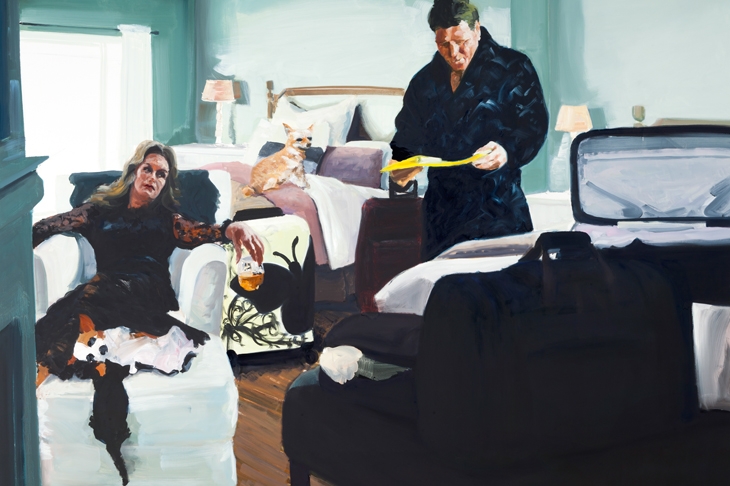René Magritte was fond of jokes. There are several in René Magritte (Or: The Rule of Metaphor), a small but choice exhibition at Luxembourg & Dayan, 2 Savile Row W1 (until 12 May), that includes numerous variations, accomplished and disturbing, on similar ideas to his famous ‘Ceci n’est pas une pipe’ painting.
‘L’usage de la parole VI’ (1928) contains two amorphous brown patches resembling mud or merde or molten chocolate. They are labelled as if in a scientific diagram, one with the word ‘miroir’, the other ‘corps de femme’. It’s true that Magritte could be repetitive, but his early paintings are beautiful, and the humour had a serious point. We make a cosy world with words and signs, he seems to say, but beyond those is meaninglessness: the void. On one side of ‘Le genre nocturne’ (1928) there is a naked woman, on the other an egg-shaped hole, as if punched through frescoed plaster, revealing a blank cracked wall.
A few strokes of pigment on canvas can stand for anything — mirror, human being, pipe. That’s one reason why painting continues to hold its own almost two centuries after the advent of its great rival, photography, in 1839.
Of course, the two have an intimate relationship, as is demonstrated by an exhibition at Skarstedt, 8 Bennet Street SW1 (until 26 May), of new paintings by the American artist Eric Fischl, who turned 70 last week. Fischl is one of the leading living representatives of a tradition that is often dubbed ‘American realism’ but would more accurately be termed ‘American anxiety’. He has named Edward Hopper as an exemplar — the kind of artist he is trying to be — and there is certainly an affinity between the two.
Hopper depicted mundane places and people — petrol pumps, cinemas, bars — but somehow always injected a mood of strangeness and unease. Similarly, Fischl depicts scenes from contemporary life across the Atlantic, comfortable and affluent but shot through with ambiguous emotional tension.
They are derived from photographs, which he fits together to create a moment of drama. Unlike old-fashioned narrative paintings, which told familiar stories from classical mythology or the Bible, Fischl’s present an instant from a story we don’t know (and perhaps the artist doesn’t either).
In a typical canvas, as grand in scale as any 19th-century salon drama, four bathers gather beside a pool — a favourite location for Fischl’s works. One of them, a balding middle-aged man, seems to be eyeing a younger women as she prepares to swim. An older woman, his wife perhaps, looks on.
It’s like a still from a movie, but what happens next we will never know. In a sense Fischl’s paintings are painted photo-collages, but what gives them force, again like Hopper’s, is the way the paint is put on: the juicy strokes, for example, that make up the man’s bald pate. It comes down to that mysterious factor, the painter’s touch.
Lorna Simpson is an artist best known for political works that combine photography and texts. The first part of her new show at Hauser & Wirth, 23 Savile Row W1 (until 28 April), consists of photo-collages in which she splices together images, often culled from ancient copies of magazines such as Ebony and Jet which were aimed at African American readers.
Simpson creates a frisson by intercutting these dated magazine illustrations with the surreally unexpected: a woman admires her elaborate beehive hairdo in a looking-glass while a mound of ice crystals forms on the floor at her feet. The exhibition includes sculpture and some large paintings, also based on photographic sources — icebergs and apocalyptic cloudscapes in one striking series. Over this Arctic scenery Simpson has floated washes of acrylic in the way that Robert Rauschenberg used to pour dripping pigment over the imagery of his pictures.
It works. These exhibits have energy and visual oomph. Another demonstration of the power of paint.






Comments